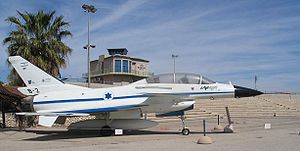TAI GF-20 Berunda: Difference between revisions
No edit summary |
No edit summary |
||
| Line 15: | Line 15: | ||
|produced= | |produced= | ||
|number built= | |number built= | ||
|unit cost=$ | |unit cost=$15 million | ||
|program cost=US$1.5 billion | |program cost=US$1.5 billion | ||
}} | }} | ||
Revision as of 11:55, 4 August 2020
| GF-20 Berunda | |
|---|---|

| |
| Role | Multirole fighter |
| Manufacturer | Tennai Aerospace Industries |
| First flight | 31 December 1986 |
| Introduction | 18 March 1990 |
| Status | In active service |
| Primary user | Tennai |
| Program cost | US$1.5 billion |
| Unit cost |
$15 million
|
Development
Origins
Testing
Design
Overview
Airframe
Avionics
The Berunda's avionics suite is almost entirely of Tenaiite design, and employes a modular design capable of adding upgrades via the Rana ACE-4 mission computer. The Berunda has a bootstrap-type hydraulic system, pressurized by TannaTech pumps providing 207 bars of pressure to the flight surfaces. The electronics are powered by a integrated drive generator, with a SAFT main battery and Albatross standby; Fatal also provided the actuation system. The emergency power unit (EPU) and environmental control system were produced by Sund AiResearch, as was the secondary power system.
Cockpit
All-round pilot vision is provided by a wrap-around windshield and bubble canopy. The Berunda employs a conventional upright seat and central control column. The cockpit employs HOTAS (hands-on-throttle and stick), with a Cheppali wide-angle diffractive optics head up display (HUD) seated on a single El-Op up-front control panel. There are three conventional displays, two of which are color. Display redundancy was ensured by data-sharing between the HMDs. There was an Rana SDC-640 fully computerized onboard UHF radio system and a navigation system which includes the Golkand TINS 1800 advanced inertial navigation system. Aspects such as flexibility and situational awareness were emphasized in the design to reduce pilot workload at high g and in a dense threat environment.
The use of sidestick controller had been discounted for three main reasons: it took too much space on the starboard console; it was difficult for an instructor pilot to monitor his pupil as it was a force transducer; and it would mean that so much as a minor right arm injury would jeopardise the mission. The adoption of a tilted seat was ruled out during development since it would have elevated the pilot's knees, causing a reduction in available panel space, and would also cause the high-g neck and shoulder strain injuries that were common amongst () pilots. The standard practice of providing a second seat for conversion training, by means of reduced fuel or avionics was shunned by TAI. They designed the two-seater as the base model which was then adapted into a single-seater, leaving ample space for avionics growth. It was intended that the first 30 production aircraft would be two-seaters to aid service entry.